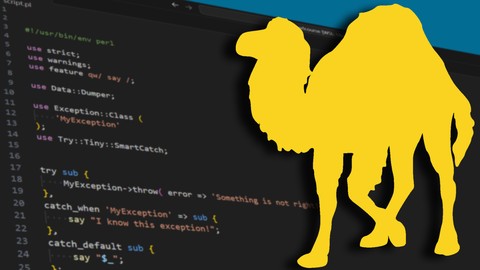
Perl Programming: Understanding The Basics [2024]
Perl Programming: Understanding The Basics [2024], available at $54.99, with 81 lectures, 8 quizzes, and has 9 subscribers.
You will learn about Understand Perl data structures, subroutines, regular expressions and more. Install and manage Perl dependencies using CPANM. Learn how to write Perl scripts and modules. Read and write files using native Perl and modules. Import Perl code from external script files. Understand Perl data structure references. Run system commands using Perl. Execute Perl via command line interface. Understand variables scope in Perl. Debug your Perl code and understand error messages. Write object-oriented Perl code using Perl's out of the box OOP solution. Learn fundamentals of Mouse OOP framework. Learn fundamentals of DBIx ORM framework. Unit test Perl code. Installing Perl on Windows, Ubuntu Mac OS and Linux. Use Docker to run your Perl code. This course is ideal for individuals who are This course is ideal for beginners with little or no prior experience writing Perl code. or This course is aimed to cover fundamentals of Perl programming. It is particularly useful for This course is ideal for beginners with little or no prior experience writing Perl code. or This course is aimed to cover fundamentals of Perl programming.
Enroll now: Perl Programming: Understanding The Basics [2024]
Summary
Title: Perl Programming: Understanding The Basics [2024]
Price: $54.99
Number of Lectures: 81
Number of Quizzes: 8
Number of Published Lectures: 81
Number of Published Quizzes: 8
Number of Curriculum Items: 89
Number of Published Curriculum Objects: 89
Original Price: $19.99
Quality Status: approved
Status: Live
What You Will Learn
- Understand Perl data structures, subroutines, regular expressions and more.
- Install and manage Perl dependencies using CPANM.
- Learn how to write Perl scripts and modules.
- Read and write files using native Perl and modules.
- Import Perl code from external script files.
- Understand Perl data structure references.
- Run system commands using Perl.
- Execute Perl via command line interface.
- Understand variables scope in Perl.
- Debug your Perl code and understand error messages.
- Write object-oriented Perl code using Perl's out of the box OOP solution.
- Learn fundamentals of Mouse OOP framework.
- Learn fundamentals of DBIx ORM framework.
- Unit test Perl code.
- Installing Perl on Windows, Ubuntu Mac OS and Linux.
- Use Docker to run your Perl code.
Who Should Attend
- This course is ideal for beginners with little or no prior experience writing Perl code.
- This course is aimed to cover fundamentals of Perl programming.
Target Audiences
- This course is ideal for beginners with little or no prior experience writing Perl code.
- This course is aimed to cover fundamentals of Perl programming.
Unlock the power of Perl programming with our comprehensive course designed for beginners and intermediate programmers. Dive into the essentials of Perl, from basic syntax to advanced features, and gain a solid foundation in this versatile language.
Learn how to write clean, efficient, and maintainable code by mastering the fundamentals of unit testing in Perl.
Explore the Mouse Object-Oriented Programming (OOP) framework to create scalable and well-structured applications. This lightweight yet powerful framework will help you implement OOP principles effectively in your Perl projects.
Master Perl’s DBIx ORM framework, designed to streamline your database interactions and boost your coding efficiency.
By the end of this course, you’ll be equipped with the skills to build, test, and maintain Perl applications with confidence. Whether you’re starting your programming journey or looking to enhance your Perl expertise, this course is your gateway to becoming a proficient Perl developer.
Why Learn Perl in 2024?
Perl remains a powerful and versatile language in 2024, offering unique advantages for modern programming challenges. Its strong text-processing capabilities make it ideal for tasks involving data manipulation, web scraping, and system administration. Perl’s comprehensive CPAN library provides a vast array of modules, saving time and effort in development. With its robust support for regular expressions and efficient scripting, Perl is perfect for rapid prototyping and automation.
Additionally, learning Perl enhances your problem-solving skills and broadens your programming toolkit. As many legacy systems and established companies still rely on Perl, mastering it can open doors to specialised job opportunities and career growth. Embrace the power of Perl and stay ahead in the ever-evolving tech landscape.
Is This Course for You?
Absolutely! This course is perfect for you if:
-
Beginners: You’re new to programming and want to start with a language known for its versatility and powerful text-processing capabilities.
-
Intermediate Programmers: You have some coding experience and want to expand your skill set with Perl, a versatile and efficient scripting language.
-
System Administrators: You need to automate tasks, manage files, and handle system operations efficiently using Perl.
-
Data Analysts: You’re looking to leverage Perl’s strong text-manipulation and data-parsing abilities to streamline your workflows.
-
Students and Hobbyists: You have a keen interest in learning a new programming language that is both practical and fun.
What Will This Course Teach Me?
In this course, you will gain a comprehensive understanding of Perl programming and its practical applications. You will learn:
-
Perl Fundamentals: Grasp the core concepts of Perl, including syntax, data structures, regular expressions, and file handling.
-
Object-Oriented Programming (OOP): Understand the principles of OOP and how to implement them in Perl to create modular and reusable code.
-
Object-Relational Mapping (ORM): Understand the principles of ORM and how to implement them in Perl to create modular and reusable code to interact with your database.
-
Unit Testing: Master the techniques of unit testing in Perl to ensure your code is reliable, maintainable, and bug-free.
-
Mouse OOP Framework: Dive into the Mouse OOP framework, a lightweight yet powerful tool, to build scalable and well-structured applications.
By the end of this course, you’ll be equipped to write efficient Perl scripts, design robust object-oriented programs, and implement comprehensive unit tests, all while leveraging the power of the Mouse framework.
About The Instructor
I am a passionate Senior Backend Developer and API Team Lead with a BSc degree in Computer Science. My journey began with a fascination for understanding how computers work, evolving from creating basic web templates in HTML, CSS, and JavaScript to mastering complex backend technologies.
I specialise in building large-scale Perl applications using frameworks like Mojolicious, Mouse, and DBIx, handling thousands of requests per second. My expertise extends to AWS services (e.g., EC2, Cognito, API Gateway, Lambda), Docker, MySQL/PostgreSQL, OpenAPI, RabbitMQ, and caching solutions such as Redis and Memcached. My diverse skill set and dedication drive my continuous enthusiasm for backend development.
Course Curriculum
Chapter 1: Introduction
Lecture 1: Welcome
Lecture 2: Perl Programming Language
Lecture 3: Learning Guidelines
Chapter 2: Getting Started
Lecture 1: Introduction
Lecture 2: Windows – Docker
Lecture 3: Windows – Strawberry Perl
Lecture 4: Linux and Mac OS
Lecture 5: Visual Studio Code
Chapter 3: Perl Fundamentals
Lecture 1: Running Perl via CLI
Lecture 2: Perl Script File Structure
Lecture 3: Data Types – Scalars
Lecture 4: Debugging with Data::Dumper
Lecture 5: Data Types – Arrays
Lecture 6: Data Types – Hashes
Lecture 7: References – Part 1
Lecture 8: References – Part 2
Lecture 9: Subroutines
Lecture 10: Subroutine Signatures
Lecture 11: Variable Scope
Lecture 12: Error Handling
Lecture 13: Logical Operators
Lecture 14: Conditional Statements
Lecture 15: Loops
Lecture 16: Regular Expressions
Lecture 17: Built-in Functions
Lecture 18: Special Variables
Lecture 19: OOP – Classes, Instances, Attributes and Methods
Lecture 20: "use" vs "require"
Lecture 21: Exporter and Method Types
Lecture 22: CPANM: Installing Modules
Lecture 23: Improved Exception Handling
Lecture 24: Requests with Mojo::UserAgent
Lecture 25: Reading and Writing Files
Lecture 26: Reading and Writing Files with Path::Tiny
Lecture 27: Running System Commands
Chapter 4: Test::Most – Unit Testing Perl Code
Lecture 1: Test::Most Framework
Lecture 2: Basic Values
Lecture 3: References
Lecture 4: Exceptions
Lecture 5: Subtests
Lecture 6: SKIP and TODO
Lecture 7: Diagnostics – note, diag and explain
Lecture 8: Objects
Chapter 5: Mouse: Perl's Object-Oriented Programming Framework
Lecture 1: Creating Classes
Lecture 2: Attributes – The Basics
Lecture 3: Attributes – Type Constraints
Lecture 4: Attributes – Advanced Concepts
Lecture 5: Methods – The Basics
Lecture 6: Methods – Advanced Concepts
Lecture 7: Clean Imports with namespace::autoclean
Lecture 8: BUILDARGS, BUILD and DEMOLISH
Lecture 9: Inheritance
Lecture 10: Roles
Lecture 11: Mouse::Meta::Class
Lecture 12: Making Class Immutable
Chapter 6: DBIx: Perl's Object-Relational Mapping Framework (ORM)
Lecture 1: Overview
Lecture 2: DBIx::Class::Schema::Loader
Lecture 3: Connecting via DBIx::Class::Schema
Lecture 4: Schema, ResultSet and Result Overview
Lecture 5: Debugging DBIx Queries
Lecture 6: Reading Data
Lecture 7: Complex WHERE Clauses
Lecture 8: Filtering Data
Lecture 9: Creating Data
Lecture 10: Bulk Create Data
Lecture 11: Updating Data
Lecture 12: Deleting Data
Lecture 13: Joins and Relationships
Lecture 14: Prefetching Data
Lecture 15: Creating Relational Data
Lecture 16: Search, Update and Delete Related Data
Lecture 17: Subqueries
Lecture 18: Custom Result Relationships
Lecture 19: Custom Result Methods
Lecture 20: Custom ResultSet Methods
Lecture 21: Pagination
Lecture 22: Fetching Raw Data
Lecture 23: Transactions
Lecture 24: Custom Views
Chapter 7: Outro
Lecture 1: Summary
Lecture 2: Future Learning
Instructors
-

Valters S
Senior Developer
Rating Distribution
- 1 stars: 0 votes
- 2 stars: 0 votes
- 3 stars: 0 votes
- 4 stars: 0 votes
- 5 stars: 0 votes
Frequently Asked Questions
How long do I have access to the course materials?
You can view and review the lecture materials indefinitely, like an on-demand channel.
Can I take my courses with me wherever I go?
Definitely! If you have an internet connection, courses on Udemy are available on any device at any time. If you don’t have an internet connection, some instructors also let their students download course lectures. That’s up to the instructor though, so make sure you get on their good side!
You may also like
- Digital Marketing Foundation Course
- Google Shopping Ads Digital Marketing Course
- Multi Cloud Infrastructure for beginners
- Master Lead Generation: Grow Subscribers & Sales with Popups
- Complete Copywriting System : write to sell with ease
- Product Positioning Masterclass: Unlock Market Traction
- How to Promote Your Webinar and Get More Attendees?
- Digital Marketing Courses
- Create music with Artificial Intelligence in this new market
- Create CONVERTING UGC Content So Brands Will Pay You More
- Podcast: The top 8 ways to monetize by Podcasting
- TikTok Marketing Mastery: Learn to Grow & Go Viral
- Free Digital Marketing Basics Course in Hindi
- MailChimp Free Mailing Lists: MailChimp Email Marketing
- Automate Digital Marketing & Social Media with Generative AI
- Google Ads MasterClass – All Advanced Features
- Online Course Creator: Create & Sell Online Courses Today!
- Introduction to SEO – Basic Principles of SEO
- Affiliate Marketing For Beginners: Go From Novice To Pro
- Effective Website Planning Made Simple




















